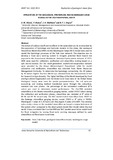| dc.contributor.author | Kiluva, VM | |
| dc.contributor.author | Mutua, F | |
| dc.contributor.author | Makhanu, SK | |
| dc.contributor.author | Ong’or, BTI | |
| dc.date.accessioned | 2023-12-15T06:53:07Z | |
| dc.date.available | 2023-12-15T06:53:07Z | |
| dc.date.issued | 2015-02-17 | |
| dc.identifier.uri | https://www.ajol.info/index.php/jagst/article/view/113175 | |
| dc.identifier.uri | http://ir-library.mmust.ac.ke:8080/xmlui/handle/123456789/2502 | |
| dc.description.abstract | The nature of surface runoff and its effects in the watershed can be represented by the application of hydrologic and hydraulic models. In this study, the Geological Streamflow Model (GeoSFM) and the Muskingum Cunge (M-C) model were used to model the hydrologic processes of the Yala river network. The objective was to develop a flood early warning system to mitigate potential flood hazard risk exposed to the downstream inhabitants. Historical hydro]metric datasets of 1975] 2005 were used for calibration, verification and streamflow routing based on a split record analysis. For the runoff generation, rainfall and evaporation datasets were provided by the Kenya Meteorological Department while for model calibration and verification, streamflow was obtained from Water Resources
Management Authority. To determine the hydrologic connectivity, the 30 meters by 30 meters Digital Elevation Model was obtained from the International Centre for Research in Agro]forestry. The Digital Soil Map of the World developed by Food and Agricultural Organisation and the Global Land Cover data of the United States Geological Survey were used for model parameterisation. The soil moisture accounting and routing method transferred water through the subsurface, overland and river phases. The percentage of the correlation coefficient (R2% value) was used to determine model performance. The GeoSFM modeled streamflow at the Bondo streamflow gauging station, coded 1FG02 where during the calibration and verification phases, streamflow was modeled at R2 value of
80.6% and 87.3% respectively. The M-C model routed streamflow from 1FG02 to the Kadenge streamflow gauging station, coded 1FG03 at R2 value of 90.8%, Muskingum K value of 2.76 hours and Muskingum X value of 0.4609. The extreme value analysis done on the modeled streamflow portrayed a unique behaviour of the system when compared to the ideal system model that should mimic the real world. It was concluded that the GeoSFM and M-C models were hence useful tools for flood mitigation by issuing flood early warning messages defined by peak streamflow and flood wave travel time. | en_US |
| dc.language.iso | en | en_US |
| dc.publisher | Journal of Agriculture, Science and Technology | en_US |
| dc.subject | Application, geological, streamflow, Muskingum, Cunge, models, River, Basin, | en_US |
| dc.title | Application of the geological streamflow and Muskingum Cunge models in the Yala River Basin, Kenya | en_US |
| dc.type | Article | en_US |

